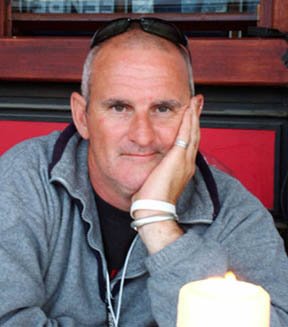Obviously I have not blogged for a few weeks - Gayle and I have been in Cambodia visiting Gayle's parents who work for OMF. There is so much to say about our experiences (sorts out blog material for a few days!). The in-laws live in Cambodia's capital - Phnom Penh, but we also managed to go up to Siem Reap (where the Angkor Wat Temples are) and down to the coast to Kep (near Vietnam) as well. There is plenty to see in Phnom Penh - standing on a street corner is an experience especially when your father-in-law is shouting from the other side telling you to cross the road despite there been thousands of motorcycles coming straight at you! But this trauma aside... Phnom Penh is where the Mekong river converges with 3 other rivers in the capital to form the Toule Sap lake, this is also home to the refugee Vietnamese boat people (probably one of the poorest group of people in Cambodia). We got around on Motodops (low cc motorbikes) or Tuk Tuk's (a carriage pulled by a motorbike) - traveling around Cambodia, especially in the city, is a real experience. The markets sell you anything and are packed full of live chickens, dried fish and live fish, glazed pigs, congealed blood (yes for sale!), more fruits than you could ever imagine, vegetables, GAP t-shirts, souvenirs, postcard sellers (usually landmine victims), watches, gems, offerings for Buddha, the list goes on. 
Typical market scene
Chickens head for tea anyone?!

Congealed blood with your chicken head?
Wat's (or temples) are everywhere as are monks, rich and poor live side by side, often poor families building a shack on top of quite a rich block of flats. Your senses are overloaded, there is always some strange sight to see - a motordop carrying a family of 7 or someone with their IV drip being taken home from the hospital, or live ducks bound by their feet tied to the back. The smell of frangipani trees lining the wide streets, cooking meat, drains, dried fish, noodle soup and rice cooking on wood fires, it is quite overwhelming at times. And it was hot and humid (up to 40c a lot of the time)
on the surface Cambodia has everything for sale as a saying goes "Cambodians can sell you nearly everything and everything nearly works". this is so true - as a country it lacks any infra-structure and corruption is rife, though it is hard to judge the policeman and the teacher and doctor who don't get paid from month to month but keep working, who then demand some bribe to pass a child's exam, to give medical care or to let to a driver pass-by for a minor traffic offence (that nobody evens knows if it is law or not!). we held many discussions with each other about how on earth this kind of situation is ever solved. It would certainly take a real crusader to sort it out. Despite all this and Cambodia's horrific past the Khmer people are very friendly, welcoming and helpful. They certainly know how to smile!
There are many many NGO (Non governmental organizations) working in Cambodia trying to change things for the people there, in fact it seems that ex-pats support the economy - if you pulled them all out there would be so little money coming in to Cambodia you have to wonder what would happen, though it might sort out some of the corruption!
traveling outside the capital also was fascinating - trucks, buses, cars, motordops and bicycles and cows with carts hurtling towards each other on roads that were not built for 2 way traffic! In fact some of the roads were not built!! trucks and buses were jammed with people and their purchases or goods for sale- infact some mini-buses had seat extentions out the back to accommodate all the travelers and their baggage!
we whizzed past wooden huts on stilts, rice paddies, children playing in the puddles (Cambodians seems to love swimming), water buffalo ploughing the fields. I think what amazed me was that many places we passed on our travels did not have electric but many had a large TV aerials poking out of their homes despite their home being nothing more than four walls of cardboard and a tarpaulins roof!
Perhaps one of the more depressing days Gayle and I spent was visiting Toul Sleng and the Killing Fields of Choeung Ek. Though it is obviously set up for tourists it is something that every visitor to Cambodia needs to do. Toul Sleng High School was taken over by Pol Pot's forces in the mid 1970's and soon became the largest detention and torture centre in the country. In the space of 3years over 17000 prisoners were taken to the Killing Fields for execution. The Khmer Rouge very carefully recorded the details and photographed all their prisoners. The photos of the prisoners and of torture fill many of the rooms at Toul Sleng. There is an excellent video following the story of one prisoner which gives a real insight in to the times. When the Vietnamese liberated Phnom Penh they found 7 survivors. 14 others were being tortured as the Vietnamese entered the city - these 14 rooms were photographed and have been preserved as they were found on that day. Visiting here is profoundly depressing and there was not a lot we could say to each other afterwards. We then took the same journey out to the Killing Fields as the prisoners (bound in a truck) would have taken. Though there is not a lot to see at the Killing Fields it was not a nice place to be. Clothes and bones are still emerging from the mass graves, as you walked round bits of clothes were under your feet, a tree was marked as to where they beat babies to death (whole families were killed at once so there would be no revenge attacks), another tree held a microphone that played loud music during the killings to cover the sounds of screams. Prisoners were killed with hoes and spades to conserve bullets. There is a Memorial Stupa which houses skulls, bones and clothing form one of the exhumed graves - most of the graves are left untouched. The majority of the security forces involved in Toul Sleng and the Killing Fields were young men and women (average age 17).

Toul Sleng School

Killing Fields Stupa -found skulls
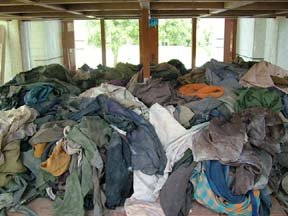
Killing Fields Stupa - found clothes
How a country's people recovers from this we do not know... There are a whole generation of people missing - a whole generation of lost skills, knowledge and wisdom.
Despite ending on such a depressing note - we loved Cambodia, its people and the way life was pushed right in to your face, as Gayle said after she had sped along on a motordop "you could not help notice you were alive!"
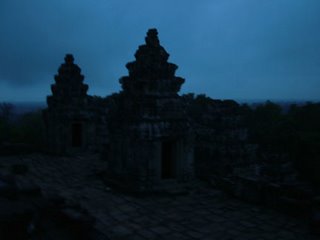


 Breakfast of mangos at a sacrificial table!
Breakfast of mangos at a sacrificial table!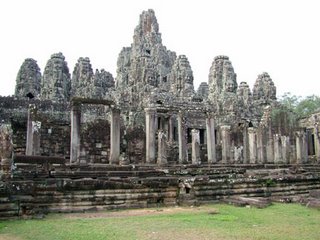
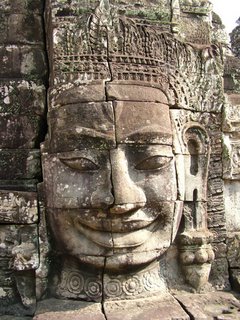

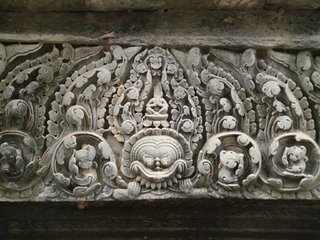
 Spring cleaning at Bayon!
Spring cleaning at Bayon! Angkor Wat - the most famous of the temples at Angkor and the largest
Angkor Wat - the most famous of the temples at Angkor and the largest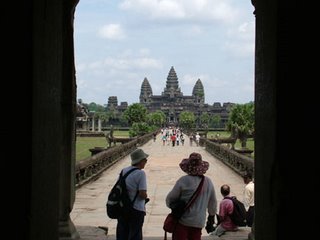

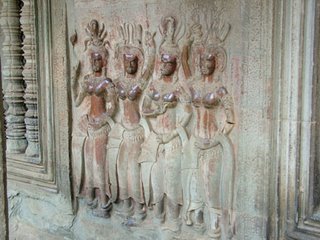 We are not sure why these beautifully carved women have particularly shiny body parts - one can only guess!
We are not sure why these beautifully carved women have particularly shiny body parts - one can only guess!
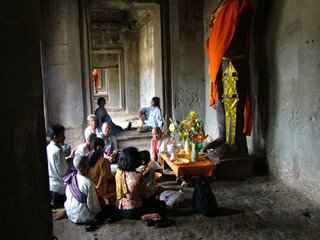
 Monks are a very common sight at the temples. The different shades of orange robes denote how long you have been a monk.
Monks are a very common sight at the temples. The different shades of orange robes denote how long you have been a monk.








